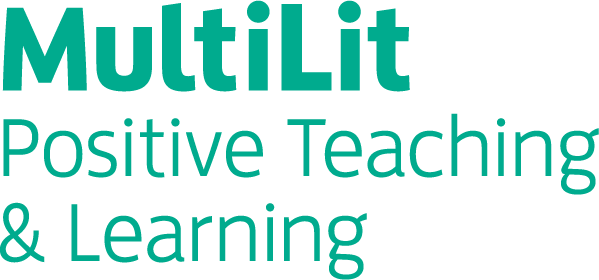A significant aspect of implementing a successful positive behaviour management strategy is measuring behaviour change and the effectiveness of interventions. With so many factors involved, it can be difficult to know what to measure, how to measure it, and what to do with the results you’ve collected.
We asked Micaela Rafferty and Jill Hellemans, the behaviour specialists behind MultiLit’s Positive Teaching and Learning Initiative, a few questions about how schools can measure positive behaviour change and why it’s important.

When it comes to positive behaviour change, what should teachers measure?
Teachers should be interested in measuring both the reduction of challenging behaviours and (more interestingly) the increase of new, more appropriate behaviours.
Imagine you’re a teacher with a student who frequently avoids tasks by verbally refusing and leaving the class. You decide to modify tasks as part of your teaching strategy and build in a reinforcement system to encourage the student to complete brief learning tasks. Taking data and systematically tracking the data over time will tell you if the intervention is successful.
Whilst you plan to track the student’s frequency of verbal refusal, you also need to think about what skills you want to see more of. You could track how many tasks were completed independently each day or how many times the student asked for help instead of refusing to complete the task.
How can a school use data to determine if their positive behaviour strategy is effective?
When measurements are taken repeatedly over time, data will tell a story that helps a school or teacher assess if the behaviour strategy is working.
The benefit of collecting this data is two-fold. Data can help in behaviour assessment, allowing you to determine when and why a student is engaging in behaviours of concern, and what might be happening to influence them. This information allows you to better tailor interventions for success. You can then use data to assess the effectiveness of an intervention plan, and to determine if the student is using alternative, more appropriate behaviours or if their behaviours are moving in the desired direction.
While it’s great for everyone to feel like progress is being made, you can’t properly determine the effectiveness of a positive behaviour strategy without data to back it up and help drive future decisions about modifying interventions and supports for your students.
How can you use data to make decisions?
Data can be used to:
- Develop targeted and effective Positive Behaviour Support Plans.
- Objectively discuss students’ needs and progress at team meetings with staff and parents.
- Inform your decisions about the interventions and supports you have in place.
- Determine the effectiveness of your plans.
- Decide when supports and strategies can be modified or faded.
What are the dimensions of behaviour you can measure?
Behaviour change is not always immediate and is definitely not linear. Understanding the different measurable dimensions of behaviour – such as how long a behaviour goes for (duration) or how often the behaviour occurs (frequency) – can help you measure even minimal changes in behaviour.
Imagine you have a student that absconds from class 10 times per day and takes, on average, 20 minutes to return to class each time. You set up interventions and want to assess the effectiveness of the plan after a few weeks. You see there is minimal change in the frequency of absconding, which still ranges from 8-10 times per day, but you see a dramatic shift in how quickly the student comes back to class. It now takes them, on average, just 5 minutes to return. If you had just focused on the frequency of absconding, you wouldn’t capture the success of the intervention at reducing the time spent away from class. This is progress!
What are the steps involved in measuring behaviour?
Data collection is not just about recording tally marks and numbers on a piece of paper. For data to be truly valuable, you need to follow several steps.
- Define the target behaviour you want to measure.
- Determine which dimensions of the behaviour are important to measure.
- Select an appropriate measurement system and data sheets to use.
- Identify who will record the data, and when, where and for how long data will be taken.
- Graph and analyse the data.
How can the Positive Teaching and Learning Initiative support schools in measuring positive behaviour change?
The Positive Teaching and Learning Initiative is a suite of workshops for teachers across three learning series. Learning Series 2: Foundations, Assessment and Measurement of Behaviour provides teachers with the skills to think functionally about behaviour and support their thinking with carefully designed measurement systems. This series explores behaviour assessment in detail and gives participants comprehensive training in completing a school-based functional behaviour assessment.
Workshop 2.1 Foundations of Behaviour and Function-based Thinking covers the science and systems supporting a function-based approach to positive behaviour change, providing an introduction to the Antecedent, Behaviour, Consequence (ABC) model. Building on this introduction, the series’ second workshop, Functional Behaviour Assessment, prepares teachers to conduct the initial stages of a school-based assessment. Participants will see examples and practice critical assessment components like interviews and data collection methods.
The third workshop in the series, Measurement of Behaviour, takes an in-depth look at the measurable dimensions of behaviour and data collection techniques. Through video content, participants will learn how to collect data and use data sheets to measure a student’s behaviour at both baseline and throughout the intervention, allowing for an understanding of progress and the overall impact of the intervention. Graphing and visual inspection techniques will teach participants how to collate and analyse the data they collect in order to make data-driven decisions.
Ask the Experts
How can your school benefit from Positive Teaching and Learning?
Book a 15-minute, no-obligation Zoom session with one of MultiLit’s Special Educators and Board Certified Behavior Analysts, Jill Hellemans or Micaela Rafferty, to receive tailored recommendations for your school.
